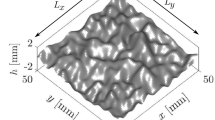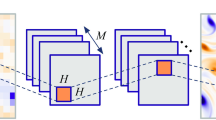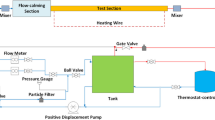Abstract
Fractality, as we introduce it, is an attribute relating to any object or system where the existence of self-similar replication of the whole is present in any order and scale. This phenomenon can be realized in any turbulent flow due to the self-similar flow structures in its energy cascade. This intrinsic natural fractality is dominant in any turbulent flow. This paper reports the effect of a forced fractality externally superimposed on a turbulent flow in a circular wind tunnel on this natural fractality. The forced fractality was created by a set of fractal orifice plates. The time correlation and energy spectra showed that the forced fractality significantly excites the natural fractality and increases flow mixing. Simultaneously, we found that the fractal orifice plate is much more efficient than the classical orifice plate with equal flow area in terms of the flow mixing.
Similar content being viewed by others
References
M. S. Uberoi and S. Wallis, Effect of grid geometry on turbulence decay, The Physics of Fluids, 10(6) (1967) 1216–1224.
P. J. Zwart, R. Budwig and S. Tavoularis, Grid turbulence in compressible flow, Experiments in Fluids, 23 (1997) 520–522.
R. Tresso and D. R. Munoz, Homogeneous, isotropic flow in grid generated turbulence, Journal of Fluids Engineering, ASME, 122 (2000) 51–56.
S. M. M. Salim, T. Saga and N. Taniguchi, Experimental analysis of the control of turbulent intensity in a square channel, JSME, 10 (2004) 563–564.
F. Murzyn and M. Bélorgey, Experimental investigation of the grid-generated turbulence features in a free surface flow, Experimental, Thermal and Fluid Science, 29 (2005) 925–935.
M. Kearney, Process intensification using engineered fluid transporting fractals, AIChE Nat. Meeting (2003).
F. Nicolleau, S. Salim and A. Nowakowski, Experimental study of turbulent pipe flow through a fractal plate, J. Turbulence, 12(44) (2011) 1–20.
C. J. Keylock, K. Nishimura, M. Nemoto and Y. Ito, The wake structure from fractal fences: Implications for the control of turbulence suspensions, JSPS (2005).
D. Hurst and J. C. Vassilicos, Scalings and decay of fractalgenerated turbulence, Phys. Fluids, 19 (2007) 035103.
R. E. Seoud and J. C. Vassilicos, Dissipation and decay of fractal-generated turbulence, Physics of Fluids, 19 (2007) 105108.
N. Lesmoire-Gordon, Will rood and ralph edney, Introducing Fractal Geometry, Icon Books, UK (2000).
A. N. Kolomogorov, The local structure of turbulence in incompressible viscous fluid for very large Reynolds numbers, C.R.Acad.Sci. U.R.S.S., 30 (1941) 301.
N. Sánchez and E. J. Alfaro, The fractal distribution of HII regions in disk galaxies, The Astrophysical Journal Supplement Series, 178 (2008) 1–19.
D. Queiros-Conde and J. C. Vassilicos, Intermittency in turbulence and other dynamical systems, Chapter: Turbulent wakes of 3-D fractal grids, Cambridge University Press, (2000).
R. D. Mehta and P. Bradshaw, Design rules for small low speed wind tunnels, The Aero. J. of the Royal Aero. Soc., Technical Notes (1979).
F. Jørgensen, How to measure turbulence with hotwire anemometers — A practical guide. Dantec Dynamics (2002).
Author information
Authors and Affiliations
Corresponding author
Additional information
S. M. Muztaba Salim is a full-time graduate student at the University of Sheffield, United Kingdom. His research interests include experimental fluid dynamics, turbulence, flow control, etc.
F. Nicolleau is a full-time Senior Lecturer at the Department of Mechanical Engineering, University of Sheffield, United Kingdom. He is actively engaged in both computational and experimental turbulence research, flow control, fluidics, etc.
Rights and permissions
About this article
Cite this article
Muztaba Salim, S.M., Nicolleau, F. Fractality in turbulence. J Mech Sci Technol 26, 1311–1314 (2012). https://doi.org/10.1007/s12206-012-0329-3
Received:
Revised:
Accepted:
Published:
Issue Date:
DOI: https://doi.org/10.1007/s12206-012-0329-3




